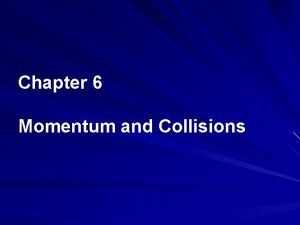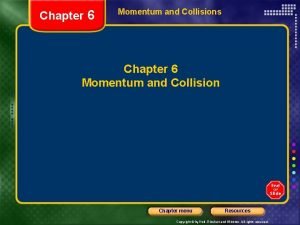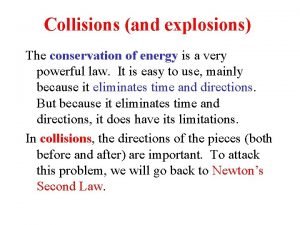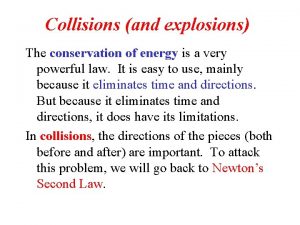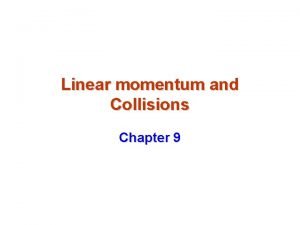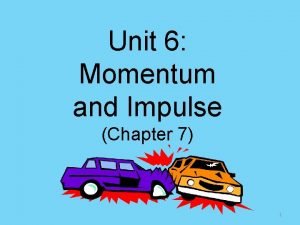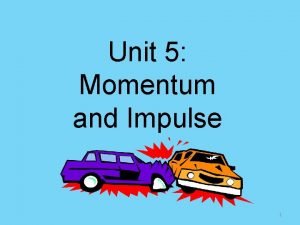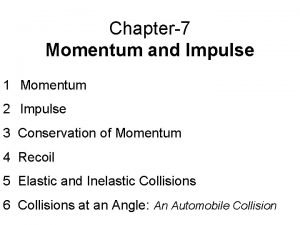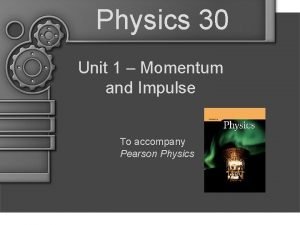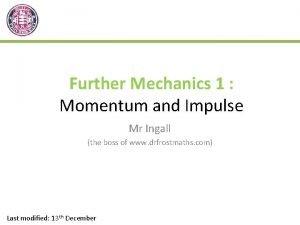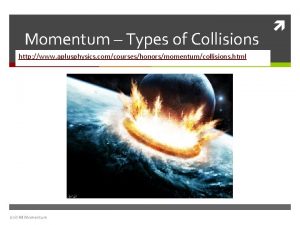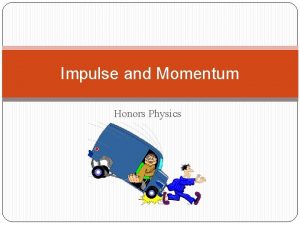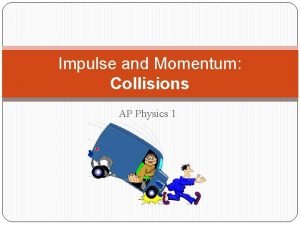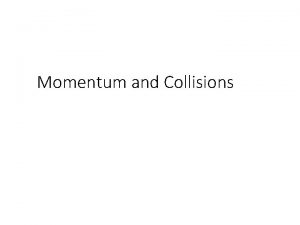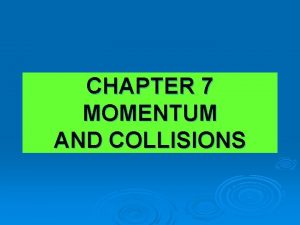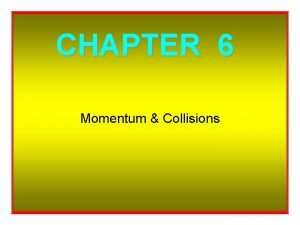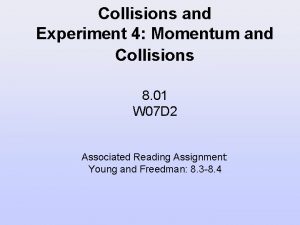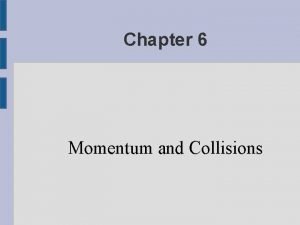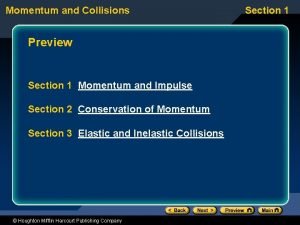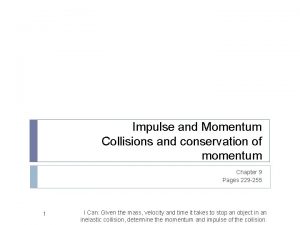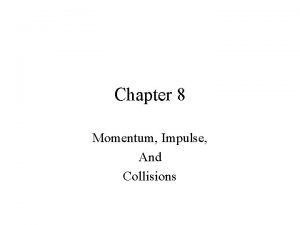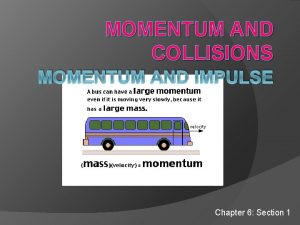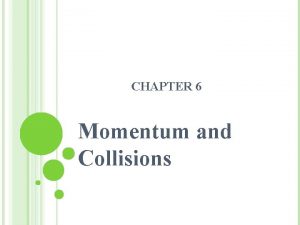Unit 5 Notes Momentum Collisions Momentum and Collisions




















- Slides: 20

Unit 5 Notes

Momentum & Collisions

Momentum and Collisions Momentum is a quantity of motion that depends on both the mass and velocity of the object in question: The units of momentum are: or vector Remember: Momentum is a ________ quantity, with the same sign as its velocity. As with any vector you can assign any direction as positive and the opposite as negative, but as convention we will refer to up or to the right as positive and down or to the left as negative.

Example A baseball pitcher hurls a ball at 32 m/s. The batter crushes it and the ball leaves the bat at 48 m/s. What was the ball’s change in momentum? m = 0. 1 kg v 0 = -32 m/s v = 48 m/s Remember that momentum is a vector which means: Left = “-” Right = “+”

Impulse Impulse = Change in momentum mass and Derivation: Recall that momentum is the product of _____ velocity ______. Since we will not be dealing with changing masses, we can define an object’s change in momentum as: Whenever a net force acts on a body, an acceleration results and so its momentum must change.

Examples A student jumps off a desk. When they land they bend their knees on impact. Why does this help prevent some serious damage to their knees? constant Increasing the time of the impact reduces the amount of force the student experiences.

Examples Coaches for many sports such as baseball, tennis, and golf can often be heard telling their athletes to “follow through” with their swing. Why is this so important? Increasing the time of the collision while keeping the force constant increases the velocity of the ball.

Examples Conventional wisdom suggests that cars should be made tough and rigid to prevent injury during a collision, however newer vehicles are all built with large crumple zones. Why? The crumple zone collapses which extends the time of Constant the collision, reducing the force experienced by the passengers.

Examples A beanbag and a high bounce ball of equal masses are dropped from the same height. The beanbag is brought to a stop in the same time that the ball is in contact with the floor. Which one exerts a greater average force on the floor? constant

Example A 115 kg fullback running at 4. 0 m/s East is stopped in 0. 75 s by a head-on tackle. Calculate The impulse felt by the fullback. The impulse felt by the tackler. Newton’s 3 rd Law: same force in the opposite direction The average net force exerted on the tackler.

Example A 1250 kg car traveling east at 25 m/s turns due north and continues on at 15 m/s. What was the impulse the car exerted while turning the corner? m = 1250 kg v 0 = 25 m/s east v = 15 m/s north Δp = ?

The Law of Conservation of Momentum

The Law of Conservation of Momentum is a useful quantity because in a closed system it is always conserved. This means that in any collision, the total momentum before the collision must equal the total momentum after the collision. There are two ways of thinking about the conservation of momentum: (1) (2)

The Law of Conservation of Momentum Collisions can be grouped into two categories Elastic Collisions: - KE is conserved - Kebefore = KEafter - Momentum is always conserved - Total energy is conserved Inelastic Collisions: - KE is not conserved

The Law of Conservation of Momentum In reality, collisions are generally somewhere in between perfectly elastic and perfectly inelastic. As a matter of fact, it is impossible for a macroscopic collision to ever be perfectly elastic. Perfectly elastic collisions can only occur at the atomic or subatomic level. Why can’t macroscopic collisions ever be truly elastic? - A change in shape - Sound - Other vibrations heat - Work done

Inelastic Collisions Two rugby players of equal mass collide head on while traveling at the same speed. 0 m/s What is their final speed? yes Is momentum conserved? Is energy conserved? Is kinetic energy conserved? yes no

Inelastic Collisions A 9500 kg caboose is at rest on some tracks. An 11000 kg engine moving east at 12. 0 m/s collides with it and they stick together. What is the velocity of the train cars after the collision? m 1 = 9500 kg m 2 = 11000 kg V 0, 1 = 0 m/s V 0, 2 = 12. 0 m/s v=?

Elastic Collisions A proton traveling at 2 x 103 m/s collides with a stationary proton and comes to rest. What Is is the final speed of the other proton? kinetic energy conserved? yes

Elastic Collisions An alpha particle has a mass approximately 4 times larger than a proton. A proton traveling to the right at 3200 m/s strikes a stationary alpha particle and rebounds at 1920 m/s. What is the final speed of the alpha particle? m 1 = 4 m 2 v 0, 1 = 0 m/s v 0, 2 = 3200 m/s v 1 = ? v 2 = -1920 m/s

Explosions A firecracker is placed in a pumpkin which explodes into exactly two pieces. The first piece has a mass of 2. 2 kg and flies due east at 26 m/s. The second chunk heads due west at 34 m/s. What was the initial mass of the pumpkin? m 1 = 2. 2 kg m 2 = ? v 0 = 0 m/s v 1 = 26 m/s v 2 = -34 m/s mpumpkin = ?
 A 1850 kg luxury sedan stopped
A 1850 kg luxury sedan stopped Momentum and collisions review
Momentum and collisions review Perfectly elastic collision
Perfectly elastic collision Chapter 6 momentum and collisions
Chapter 6 momentum and collisions Momentum is conserved in all collisions
Momentum is conserved in all collisions What makes some collisions elastic and others inelastic
What makes some collisions elastic and others inelastic Collisions and explosions
Collisions and explosions Collisions
Collisions What is inelastic collision
What is inelastic collision Conceptual physics momentum
Conceptual physics momentum Hhd vcaa
Hhd vcaa Unit 6 review questions
Unit 6 review questions Cube wisc
Cube wisc Unit 6 momentum and impulse
Unit 6 momentum and impulse Unit of momentum and impulse
Unit of momentum and impulse Impulse and momentum
Impulse and momentum Momentum and impulse physics 30
Momentum and impulse physics 30 Further mechanics 1 unit test 1 momentum and impulse
Further mechanics 1 unit test 1 momentum and impulse Aplusphysics momentum-impulse answer key
Aplusphysics momentum-impulse answer key Impulse and momentum
Impulse and momentum Impulse law
Impulse law
